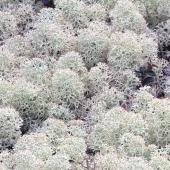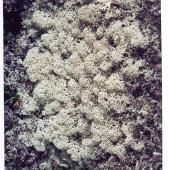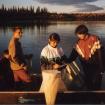White Moss (Reindeer lichen)
Gwichya Gwich'in Name:
uhdeezhù’
Teetł’it Gwich’in Name::
uudeezhu’
Latin Name:
Cladina species
Categories:
This lichen grows in large mats in spruce forests, where it is often eaten by caribou. According to Alfred Semple, Lazarus Sittichinli said it takes a long time to grow. He also told Alfred that if you eat animals that eat willow, like moose, you will get hungry more quickly than eating animals that eat lichen, like caribou. William Teya said, as children, they were taught to respect the lichen. Children were not supposed to play on it and if you took some, you were to pay for it.
As medicine
White moss can be boiled to make a tea. Mary Kendi of Fort McPherson, and Elizabeth Greenland, agreed that boiling and drinking the juice (tea) is good for stomach and chest pains. It is especially valuable if people are low on food or dog food. Annie Norbert said that men used to drink this tea before going to the mountains because it helped them keep their wind for walking and climbing. Lichen can also be mixed with dog food or grass from muskrat pushups to rid dogs of tapeworms.
As food
Lichen can be dried and ground and mixed in soups as an extender. The lichen itself can be eaten after being boiled twice and strained. Tony Andre’s mother, Julienne, would boil lichen for an hour and then fry it. Eating the fried lichen was like eating cornflakes, he said. It’rik is the stomach (rumen) contents from a caribou. The it’rik, which is mostly lichen, can be placed on meat to tenderize it and enhance the taste. The best it’rik is obtained from a caribou shot early in the morning before it has begun to eat. It’rik from the stomach of a young caribou can be hung to age for a few days to a week, and then mixed with fat, marrow, berries or sugar to make a paste. This paste can be eaten alone or fried with marrow and fat. It’rik can also be boiled and eaten as soup, or added to boiling caribou meat. It’rik enhances a person’s appetite.
As cleaner
When out on the land, lichen is good for scrubbing pots and pans.
Source: Andre, Alestine and Alan Fehr, Gwich'in Ethnobotany, 2nd ed. (2002)





